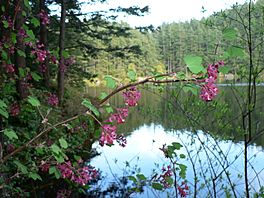Little Cranberry Lake (Washington) facts for kids
Quick facts for kids Little Cranberry Lake |
|
|---|---|

Redflower currant with Little Cranberry Lake (behind)
|
|
| Location | Anacortes, Washington, United States |
| Coordinates | 48°29′38″N 122°38′31″W / 48.4940°N 122.6420°W |
| Basin countries | United States |
Little Cranberry Lake is a beautiful lake found within the Anacortes Community Forest Lands. This special area is located on Fidalgo Island in the northwestern part of Washington State, USA. The lake is a popular spot for swimming and enjoying nature.
The lake was made deeper by a dam built on its northern side in the 1930s. Before that, an older dam broke in 1921. When it broke, a lot of water rushed down the hills all the way to the beach!
Contents
Exploring Little Cranberry Lake
The area around Little Cranberry Lake is part of a long, wild corridor. This corridor stretches for about 10 miles from north to south. It roughly follows an ancient moraine, which is like a big ridge of rocks and dirt left behind by a glacier long ago. This moraine is also a major source of gravel for the nearby city of Anacortes, Washington.
Trails and Activities
The trails in this area are kept up, but their quality can vary. Almost all of them are great for mountain biking, which makes the lake a fun place for adventure. Little Cranberry Lake is also a very popular place for swimming, especially for people who visit the annual summer music event called What the Heck Fest.
Wildlife and Nature
The Little Cranberry Lake area is home to many different kinds of animals and plants. It's a great place to see wildlife!
Animals You Might See
You can find many animals in the Little Cranberry basin. These include Coyotes, deer, beavers, grouse, pelicans, hawks, and even bald eagles. You might also spot Canada geese, mallards, and many different types of reptiles and insects. Hunting is not allowed here, so the animals are safe.
South of the lake, there are swamplands. These swampy areas have been growing bigger and deeper since about 1985, which is when beavers moved into the area. Beavers build dams, which can change the water levels and create more wetlands.
Special Plants and Trees
Some types of orchids grow in this area that might be very rare or unique. The land around the lake was mostly cut down for timber between 1890 and 1920. However, some of the trees in harder-to-reach spots, like those on the southern end of the lake, are old growth. This means they are very old and have never been cut down.
Locals say that until the 1950s, morel mushrooms were very easy to find here. But by 2005, it became almost impossible to find them.



